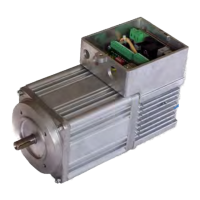
Do you have a question about the gefran KFM05a and is the answer not in the manual?
General safety precautions for drive converters, including handling and installation guidelines.
Details specified usage, EC directives, and EMC compliance for drive converters.
Guidelines for safe transport, storage conditions, and installation procedures for the drive converter.
Safety notes for electrical connections, operation, and maintenance of the drive converter.
Lists various industrial applications suitable for the KFM05a positioning motor.
Describes the integrated technology, encoder resolution, and software capabilities of the KFM05a.
Provides detailed technical specifications including power, torque, speed, and electrical data.
Illustrates the speed versus torque performance curves for different KFM05a models.
Specifies the permissible radial and axial forces on the motor shaft.
Presents physical dimensions and mounting details of the KFM05a motor.
Explains the coding system used for product order numbers.
Details options for gear, varnishing, software, and manuals.
Interprets the information presented on the product's nameplate.
Describes different housing types, IP ratings, and connector configurations available.
Provides essential guidelines for proper mounting and cooling of the KFM05a.
Lists and describes optional features like brakes, safety relays, and enhanced power supplies.
Details the arrangement and labeling of terminals on the controller board.
Explains the specific connections and functions of various terminals (X7, X6, X12, etc.).
Guides on setting jumpers (ST3) and DIP-switches for input logic and analog settings.
Details the pin assignment and usage of the D-Sub 9 connector for RS 232 communication.
Describes connections for optional features like holding brakes, analog outputs, and keypads.
Provides recommended wiring diagrams for analog and digital signals.
Shows and describes the connectors used in the light version of the KFM05a.
Details pin assignments for mains and control connections in the light version.
Shows and describes the connectors used in the heavy version of the KFM05a.
Details pin assignments for mains and control connections in the heavy version.
Explains the configuration and operation of digital and analog inputs.
Describes the logic and functionality of the digital outputs.
Details programming methods via RS 232 and the E@syDrive software.
Explains the critical role of the enabling input for power amplifier operation.
Guides on installing and setting up the E@syDrive software for parameter configuration.
Instructions for connecting the KFM05a to a PC and configuring the communication interface.
Steps to launch and navigate the E@syDrive software application.
Details on using the configurator for parameter management and diagnostics.
Explains how to retrieve help information for parameters within the configurator.
Describes how to perform motor tests using the E@syDrive diagnosis page.
Details the 13 different configuration modes for digital inputs.
Outlines specific functions for door operation, including torque limitation.
Explains the operational principles of position control with associated graphs and formulas.
Clarifies absolute and relative positioning, reference points, and homing procedures.
Instructions on how to view past fault messages and alarms through the History function.
Provides a list and explanation of various alarm codes and their meanings.
Introduces the KFM_LOAD program for firmware updates.
Details the steps for loading new firmware onto the KFM05a.
Introduces the optional keypad, its features, and mounting.
Explains the functions of the keypad's LEDs, display, and buttons.
Describes the meaning of each LED indicator on the keypad.
Details the information shown on the keypad's 4-line display.
Lists the functions of each button on the keypad for navigation and operation.
Explains the operator menus, parameter changes, and how to save data permanently.
Outlines the structure of the operator menus, including Monitor, Frequency Control, and Positioning.
Details the parameters available for display in the Monitor menu.
Lists and explains the setpoints for frequency control.
Describes parameters relevant for customer-specific settings, like door functions.
Details the parameters used for configuring positioning operations.
Explains how to read and interpret error codes from the error memory.
Describes the procedure for saving and backing up parameters.